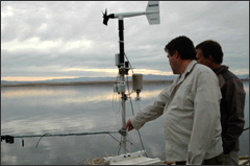
The semi-annual meeting of the Landsat Calibration Working Group was held November 28-29 in Palm Springs, CA. Participants included representatives from the NASA/GSFC Land-cover satellite Project Science Office and the USGS Landsat Project who work jointly to maintain the geometric and radiometric performance of the Landsat data products. The four vicarious radiometric calibration teams from the University of Arizona, Rochester Institute of Technology (RIT), Jet Propulsion Lab and South Dakota State University (SDSU) attended and Ball Aerospace, the Operational Land Imager contractor for the Landsat Data Continuity Mission sent a representative. Discussions of current Landsat-5 TM and Landsat-7 ETM+ performance did not indicate any major changes in radiometric or geometric performance, other than those associated with the ETM+ April 1, 2007 switch to bumper mode. Several issues did arise that will require attention:
- The switch to bumper mode operation on Landsat-7 ETM+ this year revealed some issues with the generation of the thermal band calibration processing parameters; an interim processing procedure has been implemented that corrects most of the problem and there is a long term resolution with software and parameter updates in the works. The current data processing strategy, where the data are processed to level 1G shortly after acquisition, results in the “fixes” not being applied to the distributed data for the affected period of time. This is an issue for other geometric and radiometric parameter updates as well and is currently being worked by USGS/EROS.
- The switch to bumper mode operation of Landsat-7 ETM+ also degraded the geodetic accuracy: Post April 1, 2007 65% of scenes had geodetic accuracy RMSE < 50 meters; prior to this 97% met this criterion (since the beginning of the “quiet gyro” period on March 14, 2005). This is a consequence of the fact that the fixed scan-start and -stop angles provided by the scan angle monitor are not used to control the scan mirror when operating in bumper mode.
- The current several month hiatus in the Landsat-5 TM operations due to battery problems will result in some geometric (and perhaps radiometric) discontinuities and intensive calibration efforts if and when operations resume.
Work is also progressing on tying the Landsat-4 TM radiometric calibration to Landsat-5 TM and very encouraging results were presented on verifying the Landsat-5 TM thermal band calibration prior to Landsat-7 launch using buoys on the Great Lakes. The team visited Simon Hook’s (JPL) thermal vicarious calibration platform on the Salton Sea. The site has the advantage of providing a large water body at warm temperatures in the summer providing a higher temperature for thermal calibration. It is a challenging environment to work in due to the high salinity (and other dissolved materials) of the water.






